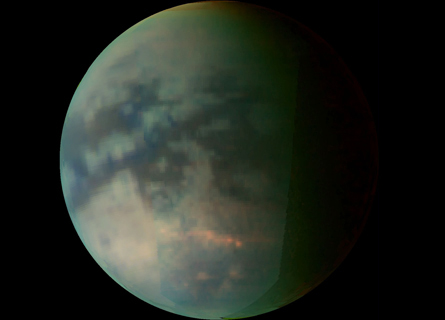 How the moon got its water, plus more in this week’s news
How the moon got its water, plus more in this week’s news
Titan’s cirrus clouds
The Cassini spacecraft has measured the abundance and composition of wispy clouds high in the smoggy atmosphere of Saturn’s frigid moon Titan. The cirruslike ice clouds, which Cassini finds throughout the atmosphere, can be used to trace the changing abundance of icy particles — nitrites and hydrocarbons — at different altitudes and with Titan’s seasons, Carrie Anderson of NASA’s Goddard Space Flight Center in Greenbelt, Md., and Robert Samuelson of the University of Maryland in College Park report in an upcoming Icarus. For instance, because gas moves from warmer to colder regions, the wintry northern hemisphere now harbors more ice clouds than the south. —Ron Cowen
How the moon got its water, plus more in this week’s news
Titan’s cirrus clouds

Saturn’s moon Titan has a smoggy atmosphere, shown here in a portrait by the spacecraft Cassini, and new research reveals wispy clouds within that smog that shift with the seasons.
The Cassini spacecraft has measured the abundance and composition of wispy clouds high in the smoggy atmosphere of Saturn’s frigid moon Titan. The cirruslike ice clouds, which Cassini finds throughout the atmosphere, can be used to trace the changing abundance of icy particles — nitrites and hydrocarbons — at different altitudes and with Titan’s seasons, Carrie Anderson of NASA’s Goddard Space Flight Center in Greenbelt, Md., and Robert Samuelson of the University of Maryland in College Park report in an upcoming Icarus. For instance, because gas moves from warmer to colder regions, the wintry northern hemisphere now harbors more ice clouds than the south. —Ron Cowen
Massive starbirthing
The European Space Agency’s Herschel infrared telescope has begun mapping dark, cold clouds of gas that are the likely birth sites of the Milky Way’s most massive stars. By measuring the temperature of the clouds, Herschel has now identified which gas clumps have begun to form stars and which ones are likely to be on the verge of doing so, shedding new light on the star-forming process. An international team of researchers posted their study of the cold gas clouds at arXiv.org on January 27. —Ron Cowen
Moon water
Planetary scientists say they have new evidence for the role that the solar wind plays in generating the water recently found on the moon. An analysis of data recorded by

 Previous page
Previous page Back to top
Back to top







